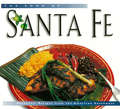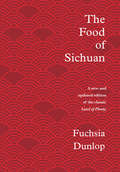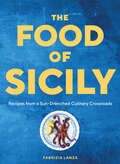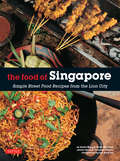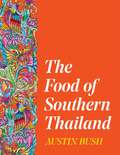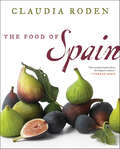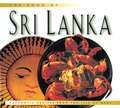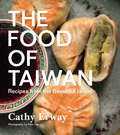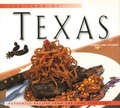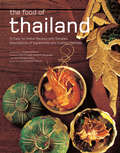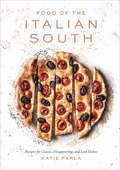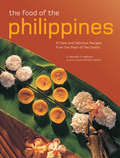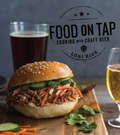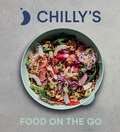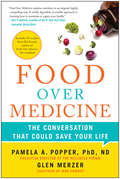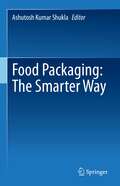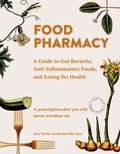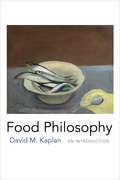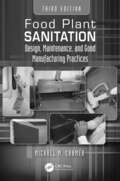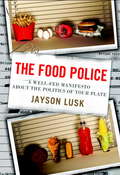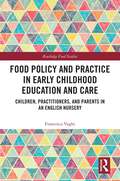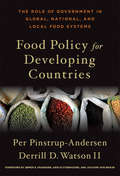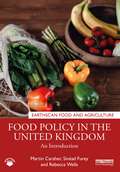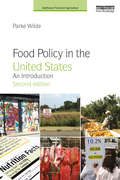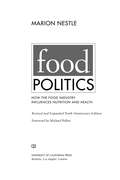- Table View
- List View
The Food of Santa Fe: Authentic Recipes from the American Southwest
by Dave Dewitt Nancy GerlachThese beautiful books offer complete information on ingredients, utensils, and cooking techniques. Each volume presents the best authentic recipes and detailed explorations of the cultural context in which dishes are created and enjoyed. Each title contains 70 to 90 beautiful full-color photographs and a range of mouth-watering recipes by some of the area's best chefs. Copyright © Libri GmbH. All rights reserved.
The Food of Sichuan
by Fuchsia DunlopNamed one of the most anticipated cookbooks of Fall 2019 by Bon Appétit, Eater, Epicurious, and Literary Hub. An essential update of Fuchsia Dunlop’s landmark book on Sichuan cuisine, with 200 recipes and stunning photographs. Almost twenty years after the publication of Land of Plenty, considered by many to be one of the greatest cookbooks of all time, Fuchsia Dunlop revisits the region where her own culinary journey began, adding more than 70 new recipes to the original repertoire and accompanying them with mouthwatering descriptions of the dazzling flavors and textures of Sichuanese cooking. Food of Sichuan shows home cooks how to re- create classics such as Mapo Tofu, Twice-Cooked Pork and Gong Bao Chicken, or a traditional spread of cold dishes, including Bang Bang Chicken, Numbing-and-Hot Dried Beef, Spiced Cucumber Salad and Green Beans in Ginger Sauce. With gorgeous food and travel photography and enhanced by a culinary and cultural history of the region, The Food of Sichuan is a captivating insight into one of the world’s greatest cuisines.
The Food of Sicily: Recipes from a Sun-Drenched Culinary Crossroads
by Fabrizia LanzaIn this all-new cookbook from Fabrizia Lanza, one of the world&’s greatest food cultures is distilled in 75 recipes for the home cook, plus a loving tribute to its ingredients, passions, influences, and history Tucked away on an estate in the countryside south of Palermo is the Anna Tasca Lanza Cooking School, a unique center dedicated to preserving and sharing the great food culture of Sicily. The spirit of the school, now run by Fabrizia Lanza, the founder&’s daughter and scion of a renowned family of winemakers that goes back generations, is what makes Lanza&’s The Food of Sicily such a singular cookbook—not just a collection of recipes and techniques, but a vibrant and beautifully photographed profile of the land, the people, the history, and so much more. On every page, in every recipe and note, the author captures the distinct taste of Sicily. How the simplest antipasti, brightly seasoned with nothing but lemon or vinegar, open the appetite—like a classic Octopus Salad or dish of Sautéed Black Olives. The little fried somethings—like an arancine or panelle—are easy, welcome, and nourishing. The Fresh Cavatelli, Pasta with Eggplant and Tomatoes, Bucatini with Sardines and Wild Fennel, and the eye-opening Anelletti Timballo explain why Sicilians are the biggest pasta eaters in the world. Festive meat dishes—such as Lamb-Stuffed Pastry, an Easter staple, or Grilled Sausage with Bay Leaves and Onions—are festive because the moment it&’s holiday time, Sicilians everywhere head outside and fire up their grills. And for a people known for their passion for sweets, some famous Sicilian treats—Watermelon Pudding, Lemon Granita, Rolled Fig Cookies, and the pinnacle of desserts, the elaborate Sicilian Cake with Ricotta Cream and Marzipan. Along the way, the author delves into everything from cheese, couscous, and olives to Amaro and the importance of bitterness. Visitors to Sicily often sense it to be a place unlike anywhere else—lost in time and a little bit secretive. The Food of Sicily opens a bright window on it, celebrating this wonderful food culture while honoring everything that makes it special.
Food of Singapore
by David Wong Djoko WibisonoThe native cuisines of this diverse society have evolved into a unique and exciting blend, brought to you in this collection of strikingly illustrated dishes. You will also be introduced to the nation's dynamic cultural and culinary traditions. The Food of Singapore presents over 60 easy-to-follow recipes, with descriptions of ingredients and cooking methods, enabling you to reproduce the distinctive flavors of Singapore in your very own kitchen.
The Food of Southern Thailand
by Austin BushA beautiful, eye-opening guide to the culture and cuisine of Thailand’s south, featuring the region’s quintessential recipes: spicy noodles, coconut curries, and seafood dishes. Austin Bush has spent decades traveling across Thailand, collecting recipes, observing cooking techniques, taking photographs, and recording stories. With his documentarian’s eye, he captures the rich culinary traditions of the country’s southern region, making this the first cookbook in English to focus on the cuisine. The Food of Southern Thailand continues Austin’s ambitious project of illuminating Thailand’s foodways. Shared here are bold, spicy flavors of chile, turmeric, and black pepper that link countryside and island. Gathered, too, are cosmopolitan dishes from the cities that blend ingredients such as coconut milk and fish sauce. The food of southern Thailand is like nothing you’ve encountered before: vibrant, thanks to Thailand’s colorful larder; diverse, reflecting various waves of immigration to the region; and delicious beyond what you might find in most restaurants in the United States. In lush photographs and helpful step-by-step illustrations, Austin explores, bite by bite, the mouthwatering offerings of roadside stalls and tiny island restaurants. His detailed recipes feature the region’s most beloved dishes, including a variation on a classic tart, spicy soup with vegetables and fish, Hat Yai–Style Fried Chicken with Sticky Rice (served with a tangy dipping sauce), and Minced Kingfish Stir-Fried in a Spicy Herb Paste. Sweets from the region are unique, often wrapped in banana leaves and filled or dusted with local palm sugar: fragrant cashew brittle, crispy fritters, warm coconut pancakes. A dream book for armchair travelers, intrepid cooks, and those eager to explore the backroads of a beautiful country, The Food of Southern Thailand is a crucial record of a cuisine as it is lived now. Austin’s vivid writing and careful reporting will transport all with a powerful story of a place and its people and bring one-of-a-kind dishes to life in your home kitchen.
The Food of Spain
by Claudia RodenOne of our foremost authorities on Mediterranean, North African, and Italian cooking, Claudia Roden brings her incomparable authenticity, vision, and immense knowledge to bear in The Food of Spain. The James Beard Award–winning author of the classic cookbooks A Book of Middle Eastern Food and A Book of Jewish Food now graces food lovers with the definitive cookbook on the Spanish cuisine, illustrated with dozens of gorgeous full-color photographs that capture the color and essence of this wonderfully vibrant nation and its diverse people, traditions, and culture.
Food of Sri Lanka
by Wendy Hutton Douglas BullisThis book features over 60 sumptuous recipes originating from the four corners of the island, including classics such as appa and iddiappan (eff and string hoppers), pittu (steamed rice flour rolls), kiri bath (milk rice), ambulthiyal (claypot fish), konda kaum (topknot cakes) and an array of sambol or condiments. Stunning location photography, a detailed glossary of ingredients, and comprehensive introduction to this paradise isle, make The Food of Sri Lanka the perfect companion for your adventure into the delicious world of Sri Lankan cuisine.
The Food of Taiwan: Recipes from the Beautiful Island
by Cathy ErwayThe acclaimed food writer offers an insider's look at Taiwanese cooking from home-style dishes to authentic street food in &“this appetizing collection&” (Publisher Weekly, starred review). While certain dishes from Taiwan are immensely popular, like steamed buns and bubble tea, much of the cuisine still remains relatively unknown in America. In The Food of Taiwan, Taiwanese-American Cathy Erway, the acclaimed blogger and author of The Art of Eating In, explores the rich culture, history, and culinary traditions of Taiwan—including nearly 100 recipes. Recipes range from familiar dishes, such as Pork Belly Buns, Three Cup Chicken, and Beef Noodle Soup, to more uncommon fare, like the Stuffed Bitter Melon, Oyster Noodle Soup, and Dried Radish Omelet. Tantalizing food photographs intersperse with beautiful shots of Taiwan&’s coasts, mountains, and farms as well as images of bustling city scenes, making this book just as enticing to flip through as it is to cook from.
Food of Texas
by Caroline Stuart Jacob TermansenThe Food of Texas presents the authentic flavors of Texas in all its southern glory with over ninety brilliant photos and over seventy recipes. An extensive introduction by author Caroline Stuart and Dotty Griffith, dining editor and restaurant critic for The Dallas Morning News describes the culture, history, and lore that define Texan cuisine. Cooking tips and a glossary of ingredients make it easy to wrangle authentic, delicious Lone Star staples.
Food of Thailand
by Sven Krauss Laurent Ganguillet Vira Sanguanwong Luca Invernizzi TettoniThai cuisine is unique, having drawn inspiration form such diverse sources as China and India, Persia and Portugal. <P><P>This book presents a cross-section of Thai recipes from all regions of the country-as prepared in private homes, street stalls and even palace kitchens.Produced and photographed entirely in Thailand, this book offers an in-depth look at the unique cultural origins and influences behind Thai cuisine, and provides recipes for universal favorites such as Tom Yang Goong and Pad Thai, as well as numerous sauces, dips, salads, snacks and desserts.
Food of the Italian South: Recipes for Classic, Disappearing, and Lost Dishes
by Katie Parla85 authentic recipes and 100 stunning photographs that capture the cultural and cooking traditions of the Italian South, from the mountains to the coast.In most cultures, exploring food means exploring history—and the Italian south has plenty of both to offer. The pasta-heavy, tomato-forward “Italian food” the world knows and loves does not actually represent the entire country; rather, these beloved and widespread culinary traditions hail from the regional cuisines of the south. Acclaimed author and food journalist Katie Parla takes you on a tour through these vibrant destinations so you can sink your teeth into the secrets of their rustic, romantic dishes. Parla shares rich recipes, both original and reimagined, along with historical and cultural insights that encapsulate the miles of rugged beaches, sheep-dotted mountains, meditatively quiet towns, and, most important, culinary traditions unique to this precious piece of Italy. With just a bite of the Involtini alla Piazzetta from farm-rich Campania, a taste of Giurgiulena from the sugar-happy kitchens of Calabria, a forkful of ’U Pan’ Cuott’ from mountainous Basilicata, a morsel of Focaccia from coastal Puglia, or a mouthful of Pizz e Foje from quaint Molise, you’ll discover what makes the food of the Italian south unique.
Food on Tap: Cooking With Craft Beer
by Lori RiceDiscover new ways to savor your favorite beer with 60 traditional and inventive recipes. In the age of craft beer, the varieties seem endless. From floral IPAs to rich porters and stouts, and tart lambic ales to gluten-free options, there is a beer for every taste. Food on Tap is an accessible guide to using these delicious brews to add complex flavor and exciting twists to classic and new recipes such as: Sausage Crusted Helles and Kale Quiche Summer Saison Tomato Bisque Barleywine Beef Short Rib Stew Chocolate Pecan Coconut Porter Cake Beautiful original photography will have your mouth watering, so pour a draft and get ready to cook with beer.
Food on the Go: The Chilly’s Cookbook
by Chilly'sIn Food on the Go you'll find healthy and tasty meals to suit all tastes, from sweet items such as Chia Seed Chocolate Powerpots and an On-The-Go Smoothie to fulfilling dishes including Easy Ramen, Lamb Curry Bao Buns, Bang Bang Tofu Salad and a Salmon Poke Bowl. Chapters include Breakfast, Soups & Hotpots, Wraps & Sandwiches, Salads, Snacks & Treats and Drinks, so Food on the Go will slot seamlessly into your lifestyle at any time of day.From the pioneers of reusables, these 75 easy and delicious recipes are designed to fit perfectly into your busy life - and your Chilly's products.Created to elevate your eating and drinking experience, Food on the Go is packed with convenient and exciting inspiration for every meal. Every recipe has been formulated to work dynamically with your Chilly's reusables, which will keep your food hot or cold throughout the day.
Food Over Medicine: The Conversation That Could Save Your Life
by Glen Merzer Del Sroufe Pamela A. PopperIncludes recipes from Chef Del Sroufe, author of the bestselling Forks Over Knives--The Cookbook and Better Than VeganNearly half of Americans take at least one prescription medicine, with almost a quarter taking three or more, as diseases such as diabetes, obesity, and dementia grow more prevalent than ever. The problem with medicating common ailments, such as high blood pressure or elevated cholesterol, is that drugs treat symptoms--and may even improve test results--without addressing the cause: diet.Overmedicated, overfed, and malnourished, most Americans fail to realize the answer to lower disease rates doesn't lie in more pills but in the foods we eat.With so much misleading nutritional information regarded as common knowledge, from "everything in moderation" to "avoid carbs," the average American is ill-equipped to recognize the deadly force of abundant, cheap, unhealthy food options that not only offer no nutritional benefits but actually bring on disease.In Food Over Medicine, Pamela A. Popper, PhD, ND, and Glen Merzer invite the reader into a conversation about the dire state of American health-the result of poor nutrition choices stemming from food politics and medical misinformation. But, more important, they share the key to getting and staying healthy for life.Backed by numerous scientific studies, Food Over Medicine details how dietary choices either build health or destroy it. Food Over Medicine reveals the power and practice of optimal nutrition in an accessible way.
Food Packaging: The Smarter Way
by Ashutosh Kumar ShuklaThis book reviews the science and technology of food packaging and covers the potential innovations in the food packaging sector. At the same time, it highlights the issues and prospects for linking the laboratory research to the market. In addition to typical packaging requirements such as food quality, shelf life, protection, communication, and marketing, the book emphasizes the need for novel packaging materials, including biodegradable packaging for a variety of food products. A wide range of food products has been kept in focus and includes animal-based food products such as dairy products and sea foods. The book presents the next level of packaging solutions i.e., smart packaging with the applications of potential tools such as intelligent and active packaging, and includes the latest research on emerging digital technologies for packaging development, assessment, and acceptability. It further highlights the strategies including blends, reinforcing agents, cold plasma, UV light applications, chemical, and enzymatic methods and explores the new opportunities leading to improvement in the packaging performance. Smart freshness indicator applications, including gas and time-temperature indicators for quality and safety of packaged products, have been covered in detail. The book also includes the functional characteristics of edible films and coatings, including their bioactive characteristics. Finally the book presents the rules and regulation related to packaging.
Food Pharmacy: A Guide to Gut Bacteria, Anti-Inflammatory Foods, and Eating for Health
by Lina Aurell Mia Clase"Food Pharmacy shows the extraordinary power of food to reduce inflammation, restore gut bacteria, and cure disease. Future prescriptions can be filled at the local grocery instead of at the drug store." —Dr. Mark Hyman, New York Times bestselling author of Eat Fat Get ThinThe real and practical science behind foods that will reduce inflammation, boost your immune system, and revitalize your health. The key to a healthy life is healthy eating. We know this fact, but how do we make sense of it and live it out with the myriad of information out there on gut health, autoimmune diseases, anti-inflammatory diets, and what foods to eat and not to eat?Food Pharmacy finally tells the complete story of friendly bacteria, intestinal flora, anti-inflammatory superfoods like turmeric, the difference between good and bad fats, vitamin D, and how we can reduce inflammation and heal chronic diseases by regulating our immune system with simply the right natural foods—nature’s pharmacy that will never cause you to overdose. Marrying scientific research with seventeen supplementary recipes, practical advice and tips, and a quirky, humorous voice, Food Pharmacy extolls the kitchen’s anti-inflammatory heroes—like avocado, cloves, kale, cinnamon, and green bananas—and shows you how to live your healthiest life equipped with the right knowledge and food. With facts substantiated by Professor Stig Bengmark, a former chief surgeon and stomach bacteria research scientist, Food Pharmacy is for anyone interested in learning about how what you put in your mouth affects your body’s ecosystem, and is the ultimate guide and manifesto to leading a life as anti-inflammatory and healthy as possible.
Food Philosophy: An Introduction (California Studies In Food And Culture Ser. #39)
by David M. KaplanFood is a challenging subject. There is little consensus about how and what we should produce and consume. It is not even clear what food is or whether people have similar experiences of it. On one hand, food is recognized as a basic need, if not a basic right. On the other hand, it is hard to generalize about it given the wide range of practices and cuisines, and the even wider range of tastes.This book is an introduction to the philosophical dimensions of food. David M. Kaplan examines the nature and meaning of food, how we experience it, the social role it plays, its moral and political dimensions, and how we judge it to be delicious or awful. He shows how the different branches of philosophy contribute to a broader understanding of food: what food is (metaphysics), how we experience food (epistemology), what taste in food is (aesthetics), how we should make and eat food (ethics), how governments should regulate food (political philosophy), and why food matters to us (existentialism). Kaplan embarks on a series of philosophical investigations, considering topics such as culinary identity and authenticity, tasting and food criticism, appetite and disgust, meat eating and techno-foods, and consumerism and conformity. He emphasizes how different narratives help us navigate the complex world of food and reminds us we all have responsibilities to ourselves, to others, and to animals. An original treatment of a timely subject, Food Philosophy is suitable for undergraduates while making a significant contribution to scholarly debates.
Food Plant Sanitation: Design, Maintenance, and Good Manufacturing Practices
by Michael M. CramerFood safety and quality are primary concerns in the food manufacturing industry. Written by an author with more than 40 years’ experience in the food industry, Food Plant Sanitation: Design, Maintenance, and Good Manufacturing Practices, Third Edition provides completely updated practical advice on all aspects of food plant sanitation and sanitation-related food safety issues. It offers readers the tools to establish a food safety system to help control microbiological, physical, and chemical hazards. Understanding that sanitation is integral to food safety is the foundation for an effective food safety system. Features of this new edition include new photographs, tables, and up-to-date material that better reflect current guidance on food plant sanitation, including additional information on the implementation of FSMA. The chapters address testing for and control of microorganisms in food manufacturing, including recent challenges in the industry due to pathogens such as Listeria monocytogenes. They also offer discussions on biofilms, regulatory requirements from the European Union, allergens, sanitary facility design, and describe proven best practices for sanitation as well as current sanitary requirements and regulatory changes from the FDA and USDA. In addition, the author presents methods for verifying sanitation, and provides greater differentiation of verification versus validation. The final chapters identify good manufacturing practices for employees and present a comprehensive pest management plan, including control measures and chemical interventions. The book concludes with strategies for preventing chemical and physical food safety hazards. This reference provides a practical perspective for implementing food plant sanitation and safety processes. The author has included, wherever possible, examples of procedures, forms, and documents to help novice food safety and quality professionals develop effective food safety systems.
The Food Police
by Jayson LuskA rollicking indictment of the liberal elite's hypocrisy when it comes to food.Ban trans-fats? Outlaw Happy Meals? Tax Twinkies? What's next? Affirmative action for cows? A catastrophe is looming. Farmers are raping the land and torturing animals. Food is riddled with deadly pesticides, hormones and foreign DNA. Corporate farms are wallowing in government subsidies. Meat packers and fast food restaurants are exploiting workers and tainting the food supply. And Paula Deen has diabetes! Something must be done. So says an emerging elite in this country who think they know exactly what we should grow, cook and eat. They are the food police. Taking on the commandments and condescension the likes of Michael Pollan, Alice Waters, and Mark Bittman, The Food Police casts long overdue skepticism on fascist food snobbery, debunking the myths propagated by the food elite. You'll learn:- Organic food is not necessarily healthier or tastier (and is certainly more expensive).- Genetically modified foods haven't sickened a single person but they have made farmers more profitable and they do hold the promise of feeding impoverished Africans.- Farm policies aren't making us fat.- Voguish locavorism is not greener or better for the economy.- Fat taxes won't slim our waists and "fixing" school lunch programs won't make our kids any smarter.- Why the food police hypocritically believe an iPad is a technological marvel but food technology is an industrial evilSo before Big Brother and Animal Farm merge into a socialist nightmare, read The Food Police and let us as Americans celebrate what is good about our food system and take back our forks and foie gras before it's too late!
Food Policy and Practice in Early Childhood Education and Care: Children, Practitioners, and Parents in an English Nursery (Routledge Food Studies)
by Francesca VaghiThis book is about food and feeding in early childhood education and care, offering an exploration of the intersection of children’s food, education, family intervention, and public health policies. The notion of ‘good’ food for children is often communicated as a matter of common sense by policymakers and public health authorities; yet the social, material, and practical aspects of feeding children are far from straightforward. Drawing on a detailed ethnographic study conducted in a London nursery and children’s centre, this book provides a close examination of the practices of childcare practitioners, children, and parents, asking how the universalism of policy and bureaucracy fits with the particularism of feeding and eating in the early years. Looking at the unintended consequences that emerged in the field, such as contradictory public health messaging and arbitrary policy interventions, the book reveals the harmful assumptions about disadvantaged groups that are perpetuated in policy discourse, and challenges the constructs of individual choice and responsibility as main determinants of health. Children’s food practices at the nursery are examined to explore the notion that, whilst for adults it is what children eat that often matters most, to children it is how they eat that is more important. This book contributes to a growing body of literature evidencing how children’s food is a contested domain, in which power relations are continuously negotiated. This raises questions not only on how children can be included in policy beyond a tokenistic involvement but also on what children’s well-being might mean beyond the biomedical sphere. The book will particularly appeal to students and scholars in food and health, food policy, childhood studies, and medical anthropology. Policymakers and non-governmental bodies working in the domains of children’s food and early years policies will also find this book of interest.
Food Policy for Developing Countries: The Role of Government in Global, National, and Local Food Systems
by Per Pinstrup-Andersen Derrill D. Watson IIDespite technological advances in agriculture, nearly a billion people around the world still suffer from hunger and poor nutrition while a billion are overweight or obese. This imbalance highlights the need not only to focus on food production but also to implement successful food policies. In this new textbook intended to be used with the three volumes of Case Studies in Food Policy for Developing Countries (also from Cornell), the 2001 World Food Prize laureate Per Pinstrup-Andersen and his colleague Derrill D. Watson II analyze international food policies and discuss how such policies can and must address the many complex challenges that lie ahead in view of continued poverty, globalization, climate change, food price volatility, natural resource degradation, demographic and dietary transitions, and increasing interests in local and organic food production.Food Policy for Developing Countries offers a "social entrepreneurship" approach to food policy analysis. Calling on a wide variety of disciplines including economics, nutrition, sociology, anthropology, environmental science, medicine, and geography, the authors show how all elements in the food system function together.
Food Policy in the United Kingdom: An Introduction (Earthscan Food and Agriculture)
by Martin Caraher Sinéad Furey Rebecca WellsThis book provides an introduction to food policy in the United Kingdom, examining policy development, implementation, influences and current issues. The book begins by providing a wide-ranging introduction to food policy in the UK, situating it within wider global debates and establishing key drivers, such as issues related to global citizenship, trade and finance. The use of food control as a policy lever is also discussed and contrasted with alternative approaches based on behaviour change. The book presents an overview of the history of UK food policy, from which there is much to be learned, before moving onto current challenges posed by political instability, both at home and abroad, global pandemics and cost of living crises. Foremost is the need to manage public health, including both malnutrition and obesity, while promoting sustainable and healthy diets, as well as the broader issues around addressing food security and food poverty. The book also examines public sector food initiatives, such as school food and early childhood provisions, and food regulation. As a part of food regulation, chapters examine food scares and food fraud, from chalk in flour to "horsegate". The role of media, marketing and advertising is also considered within a policy perspective. Taking a wider lens, the book also discusses the impact of global food trade and the financialisation of food on food policy in the UK and vice versa. The book is supported by instructor eResources on the Routledge website designed to support student learning as well as provide regular updates on UK food policy developments. The eResources include student activities, group exercises and links to further reading and additional resources. This book serves as a key introduction to UK food and agricultural policy for students, scholars, policymakers and professionals, as well as those interested in food systems, public health and social policy more widely.
Food Policy in the United States: An Introduction (Earthscan Food and Agriculture)
by Parke WildeThis new edition offers a timely update to the leading textbook dedicated to all aspects of U.S. food policy. The update accounts for experience with policy changes in the 2014 Farm Bill and prospects for the next Farm Bill, the publication of the 2015–2020 Dietary Guidelines for Americans, the removal of Generally Recognized as Safe (GRAS) status for trans fats, the collapse of the Trans Pacific Partnership (TPP) treaty, stalled child nutrition reauthorization legislation, reforms in food-labeling policy, the consequences of the 2016 presidential election and many other developments. The second edition offers greater attention both to food justice issues and to economic methods, including extensive economics appendices in a new online Companion Website. As with the first edition, real-world controversies and debates motivate the book’s attention to economic principles, policy analysis, nutrition science and contemporary data sources. The book assumes that the reader's concern is not just the economic interests of farmers and food producers but also includes nutrition, sustainable agriculture, food justice, the environment and food security. The goal is to make U.S. food policy more comprehensible to those inside and outside the agri-food sector whose interests and aspirations have been ignored. The chapters cover U.S. agriculture, food production and the environment, international agricultural trade, food and beverage manufacturing, food retail and restaurants, food safety, dietary guidance, food labeling, advertising and federal food assistance programs for the poor. The author is an agricultural economist with many years of experience in the nonprofit advocacy sector, the U.S. Department of Agriculture and as a professor at Tufts University. The author's blog on U.S. food policy provides a forum for discussion and debate of the issues set out in the book.
Food Politics
by Marion Nestle Michael PollanWe all witness, in advertising and on supermarket shelves, the fierce competition for our food dollars. In this engrossing exposé, Marion Nestle goes behind the scenes to reveal how the competition really works and how it affects our health. The abundance of food in the United States--enough calories to meet the needs of every man, woman, and child twice over--has a downside. Our over-efficient food industry must do everything possible to persuade people to eat more--more food, more often, and in larger portions--no matter what it does to waistlines or well-being. Like manufacturing cigarettes or building weapons, making food is big business. Food companies in 2000 generated nearly $900 billion in sales. They have stakeholders to please, shareholders to satisfy, and government regulations to deal with. It is nevertheless shocking to learn precisely how food companies lobby officials, co-opt experts, and expand sales by marketing to children, members of minority groups, and people in developing countries. We learn that the food industry plays politics as well as or better than other industries, not least because so much of its activity takes place outside the public view. Editor of the 1988 Surgeon General's Report on Nutrition and Health, Nestle is uniquely qualified to lead us through the maze of food industry interests and influences. She vividly illustrates food politics in action: watered-down government dietary advice, schools pushing soft drinks, diet supplements promoted as if they were First Amendment rights. When it comes to the mass production and consumption of food, strategic decisions are driven by economics--not science, not common sense, and certainly not health. No wonder most of us are thoroughly confused about what to eat to stay healthy. An accessible and balanced account, Food Politics will forever change the way we respond to food industry marketing practices. By explaining how much the food industry influences government nutrition policies and how cleverly it links its interests to those of nutrition experts, this path-breaking book helps us understand more clearly than ever before what we eat and why.
